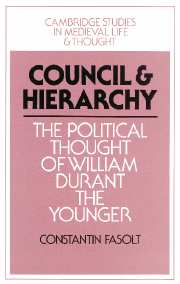Book contents
- Frontmatter
- Contents
- Acknowledgments
- List of abbreviations
- List of manuscript sigla
- INTRODUCTION
- PART I THE FORMATION OF INTEREST
- PART II THE ASSERTION OF JUSTICE
- PART III THE INCIDENCE OF POWER
- CONCLUSION
- Appendix: A note on texts and citations
- Bibliography
- Concordance
- Index
- Cambridge studies in medieval life and thought Fourth series
Appendix: A note on texts and citations
Published online by Cambridge University Press: 06 July 2010
- Frontmatter
- Contents
- Acknowledgments
- List of abbreviations
- List of manuscript sigla
- INTRODUCTION
- PART I THE FORMATION OF INTEREST
- PART II THE ASSERTION OF JUSTICE
- PART III THE INCIDENCE OF POWER
- CONCLUSION
- Appendix: A note on texts and citations
- Bibliography
- Concordance
- Index
- Cambridge studies in medieval life and thought Fourth series
Summary
There are several early modern printed editions of the lengthy treatise which William Durant the Younger wrote some time between August 1308 and the beginning of the council of Vienne in October 1311, but none of them are critical and all of them suffer from a variety of flaws. The most important is that they conflate the treatise with another, much shorter work written by Durant while the council was in session, in which he repeated some, but by no means all, of the proposals he had made in the longer work, and modified others in response to events that were taking place at the council. I refer to the first as Tractatus Maior and the second as Tractatus Minor. The title Tractatus de modo generalis concilii celebrandi, which appears in all of the printed editions and many manuscripts, is not authentic, but was coined by a fifteenthcentury copyist. It is also misleading; Durant was not writing about ‘the manner of holding a general council’ but about the reform of the church in head and members – a reform which it was his outstanding achievement to link to a particular variety of the conciliar theory. The structural differences between the printed Tractatus de modo generalis concilii celebrandi and the two treatises originally written by Durant are graphically represented on figure 2 on p. 325. For more details concerning the distinction between Tractatus Maior and Tractatus Minor see Fasolt, ‘A New View’.
- Type
- Chapter
- Information
- Council and HierarchyThe Political Thought of William Durant the Younger, pp. 321 - 325Publisher: Cambridge University PressPrint publication year: 1991



